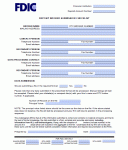In applying the $250,000 insurance limit, the FDIC must add together all deposits owned by the same depositor in the same ownership capacity. See 12 C.F.R. § 330.3(a). In the case of deposits owned by a principal but held by an agent, custodian, or nominee, the deposits are insured to the same extent as if deposited in the name of the principal. See 12 C.F.R. § 330.7(a). In other words, the insurance coverage “passes through” the agent or custodian to the principal. Such “pass-through” coverage is not available unless the deposit account records of the failed insured depository institution disclose the fiduciary relationship between the agent and the principal. See 12 C.F.R. § 330.5(b). If there are multiple levels of fiduciary relationships, those relationships must be disclosed through either of two methods:
| First Method |
|
| Second Method |
|
If these disclosure requirements are not satisfied, the deposit will be insured to the deposit broker and not to the broker’s customers. Thus, in aggregation with other deposits owned by the broker at the same insured depository institution, the deposit will be insured only up to $250,000.

